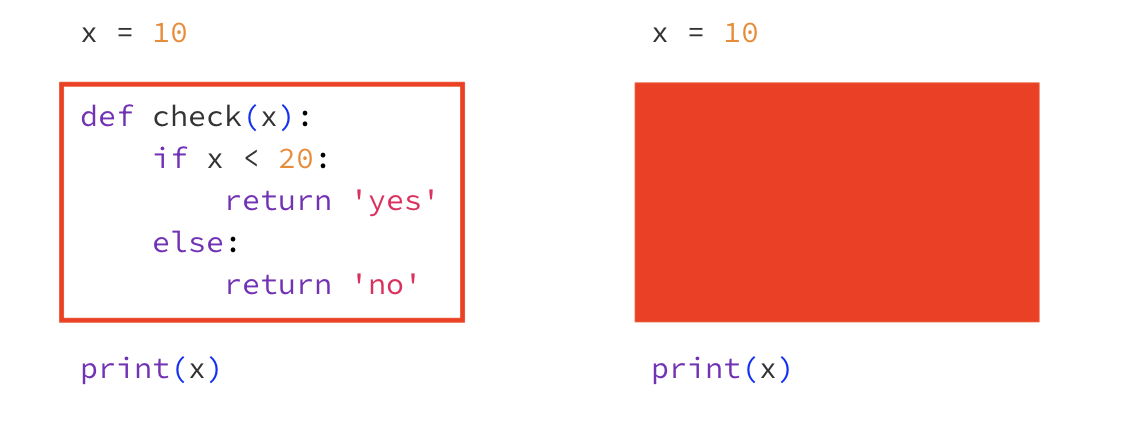4.9. Function Scope#
Variables defined inside a function are only available within the function.
This principle is know as the scope of the function and the variable exists
in the local scope of that function. If a variable is used outside the
scope in which it was defined, Python will throw a NameError.
Example
Here the variable y is created inside the function double, this means
this variable only exists inside the function and we cannot print y outside
the function. This results in a NameError (a variable of the specified
name cannot be found).
def double(x):
y = 2 * x
print(y)
Traceback (most recent call last):
File "/home/main.py", line 4, in <module>
print(y)
^
NameError: name 'y' is not defined
Similarly, x is only created inside the function, and it also only exists
inside the function, so we cannot print x outside the function and we get
a NameError.
def double(x):
y = 2 * x
print(x)
Traceback (most recent call last):
File "/home/main.py", line 4, in <module>
print(x)
^
NameError: name 'x' is not defined
You can visualise this by drawing a box around your functions. Variables that are only defined inside the box cannot be seen outside the box. If it helps, you can make your box opaque to simulate your main program being unable to ‘see in’ to your function.

Here you can see that to the rest of the program x and y don’t exist.
4.9.1. Global Scope#
While variables created inside functions cannot be seen outside of the function, any variable defined in the main program can still be seen inside the function. An example of where this might be useful is when defining constants.
Example
The function below calculates the speed of an object at time \(t\) after it
has been dropped. The function is able to ‘see’ g, which stores the
acceleration due to gravity since g is defined outside the function.
g = 9.8 # acceleration due to gravity (m/s^2)
def speed(time):
return g*time
print(speed(5))
49.0
Question 1
Will the following code cause a NameError?
def add(x, y):
s = x + y
return s
Solution
No.
This code does not cause a NameError because s is defined within the local scope of the add function, and it is used within the same function.
Question 2
Will the following code cause a NameError?
x = 10
def check(x):
if x < 20:
return 'yes'
else:
return 'no'
print(x)
Question 3
What do you expect the output of the following code to be?
x = 10
def check(x):
if x < 20:
return 'yes'
else:
return 'no'
print(check(50))
10
50
yes
no
Solution
Solution is locked
Question 4
What do you expect the output of the following code to be?
x = 10
def check(x):
if x < 20:
return 'yes'
else:
return 'no'
check(50)
print(x)
10
50
yes
no
Solution
Solution is locked
Question 5
What is the value of price printed, when this Python code is run?
price = 100
def change_price(new_price):
price = new_price
change_price(500)
print(price)
100
500
This code has a NameError
Solution
Solution is locked
Question 6
Will the following code cause a NameError?
a = 10
b = 2
c = 3
def quadratic(x):
return a * x**2 + b*x + c
print(A)
Solution
Solution is locked
Code challenge: Energy
Write a function to calculate the energy of an object in its rest frame given the mass.
Formula
\(e = mc^2\)
where \(c = 299 792 458`\) m/s.
Function specification
name:
energyparameters:
mass(float)return: energy (
float)
Example 1
print(energy(100))
8.987551787368176e+18
Example 2
print(energy(0))
0.0
Solution
Solution is locked
Code challenge: Volume Of A Cylinder
Write a function to calculate the volume of a cylinder.
Formula
Volume of a cylinder
\(v = \pi r^2 h\)
where \(r\) is the radius and \(h\) is the height. The value of \(\pi\) can be accessed from the math module.
Function specification
name:
cylinder_volumeparameters:
radius(float),height(float)return: the volume of the cylinder (
float)
Example 1
print(cylinder_volume(2, 10))
125.66370614359172
Example 2
print(cylinder_volume(5, 5))
392.69908169872417
Solution
Solution is locked
Code challenge: 8-ball

A magic 8-ball is a special ball that can help you make a decision. Write a function called eight_ball that mimics a magic 8-ball by randomly choosing one of the following messages to display.
Message 1
Reply hazy, try again
Message 2
Signs point to yes
Message 3
You may rely on it
Function specification
name:
eight_ballparameters:
Nonereturn: message (
str)
Solution
Solution is locked
Code challenge: Fibonacci
The Fibonacci sequence is:
\(1, 1, 2, 3, 5, 8, 13, 21, 34, 55, 89, 144, ...\)
The first two terms are defined to be:
\(F_1 = 1, F_2 = 1\)
With all remaining terms defined as:
\(F_n = F_{n-1} + F_{n-2}\)
Write a function called fibonacci which, when given an integer, \(n\), will calculate the \(n^{th}\) number in the Fibonacci sequence.
Function specification
function name:
fibonacciparameters:
n(int)return: \(F_n\) (
int)
Example 1
print(fibonacci(6))
8
Example 2
print(fibonacci(10))
55
